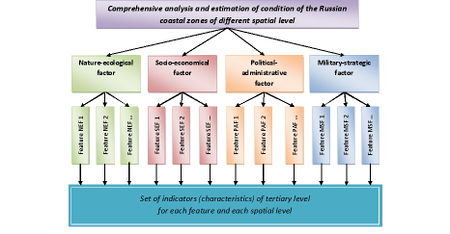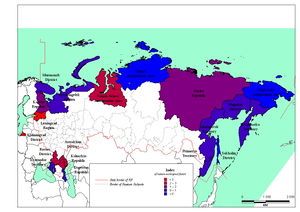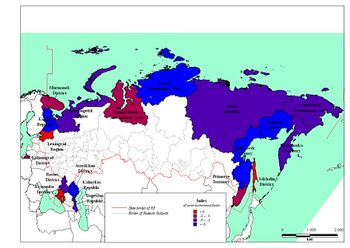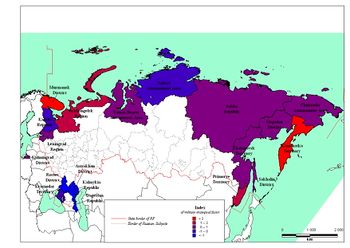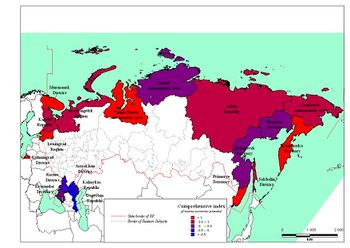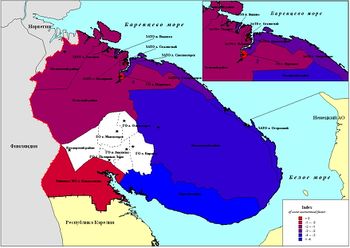Comprehensive assessment of coastal regions: the Russian example
Contents
- 1 Concept and substance of indicator methods for coastal zones
- 2 Opportunity of application of indicator techniques for the coastal zones on the regional level (examples of the Russian Federation)
- 3 Comprehensive analysis of aspects of coastal regions of the Russian Federation
- 4 Opportunity of application of indicator techniques for the coastal zones on the territorial (areas) level (examples of the Murmansk District of the Russian Federation)
- 5 References
Concept and substance of indicator methods for coastal zones
Recently in researches on study of coastal zones of the World ocean, wide recognition receives the usage of various systems of indicators for the control for changes in condition of coastal and marine zones which evaluate tendencies in social and economic conditions of the coastal and marine zones.
In general, it is necessary to understand that indicator is a quantitative or qualitative value which is received proceeding from one or several parameters describing a phenomenon or an object of research. However at qualitative significance of indicator it is necessary (if it’s possible) to reflect one in a quantitative equivalent by means of the corresponding table of transfers. The indicator system is understood as the indicator group consolidated by spatial, time or object analogy.
It is justified to offer the comprehensive system of the analysis and estimation of condition of the coastal zone. And it is possible to offer the comprehensive system consisting of 4 factors:
- The physiographic (nature-climatic) factor;
- The economic-geographical (social and economic) factor;
- The political-geographical (political-administrative) factor;
- The military-geographical (military-strategic) factor.
In turn the contents of each of the listed factors is defined by a set of features, describing the factor which actually reflects system of factors and features for the analysis and estimation of condition of the coastal zone. So accordingly, each feature, constituting in aggregate the factor, is described by set of parameters (characteristics) which are indicator of tertiary level and various depending on considered spatial level (see about spatial (governance) levels in part before). Final submission of components for the analysis and estimations of condition of the coastal zone is mapped in figure 1.
Besides it is necessary to be defined in what form an indicator can be presented. Here it is possible to offer the three-level type of indicator forms (fig. 2).
The first form (primary form) of the indicator shows the quantitative or qualitative information which maps the given indicator. Secondary form of indicator means their parametric (dimensionless) viewing and the possibility for further aggregation by any sample to the form of an integrated parameter (tertiary form of the indicator).
Let's pay attention to some assumptions which should be used by development of the indicator inter-systems and account procedures for indicators of tertiary level:
- It is recommended to refuse usage of weighting functions for each kind of parameter for account of integrated parameters since it will debatable for estimation of importance of each indicator.
- Indicators can accept value within the limits of from -1 up to +1. Thus value of the indicator -1 shows an extreme negative degree of effect of the given characteristic, and value of the indicator +1 shows as much as possible positive degree of effect of the characteristic in considered coastal region. In case if account of the indicator gives the value which is beyond this range then the indicator value starts equal to the nearest boundary significance (i.e. if indicator value < -1 then indicator value starts equal -1; if indicator value > +1 then indicator value starts equal +1). This limitation is done for exception of overwhelming effect of any indicators of one inter-system that is represented quite possible because of differences in account procedures of various indicators.
- Is quite possible to use the weighting coefficients entering into some indicators, for opportunity of the account of similar parameters, but with various degree of importance (for example, differences of statuses roads and railways, a differences in degree of education of the population, etc.). In this case it is possible to accept weighting coefficients of the corresponding state ministries and departments, and also foreign experts.
- According to requests to the indicator systems formulated above, the tasks and essence of the indicators and technique of its account should be clear not only to experts in the given field of knowledge, but also to wide layers of the population, as well as to experts in the field of management and planning. It is necessary to note the opportunity of access information which is necessary for account of the indicator, that also important for development of the indicator systems.
It is possible to mark following basic groups of techniques of indicator calculation:
- A technique based on account of the indicator on a degree of nearness of value of the considered parameter to the maximal magnitude.
- A technique based on account of the indicator on a degree of deflection of value of the considered parameter from an average.
- A technique based on account of the indicator on a degree of deflection of specific value of the considered parameter from specific value of similar parameter of higher geographical level.
- A technique based on account of the indicator on a degree of deflection of value of the considered parameter from extreme values.
Certainly, at construction and usage of indicator systems can be used a combined account procedures of indicator values.
Opportunity of application of indicator techniques for the coastal zones on the regional level (examples of the Russian Federation)
For the analysis of coastal regions of the Russian Federation we shall enter following assumptions.
First, as coastal regions of the Russian Federation we shall understand coastal Subjects of the Russian Federation.
Secondly, for more correct analysis we shall consider the following aggregates of Subjects as one region:
- The Arkhangelsk region, as aggregate of the Arkhangelsk District and Nenets Autonomous Area.
- The Leningrad region, as aggregate of Leningrad District and St. Petersburg.
Thirdly, Taimyr (Dolgano-Nenets) Autonomous Area is considered as separate region, not as the constituent of Krasnoyarsk Territory which he is since January, 1st, 2007.
So, there were viewed 19 coastal regions of the Russian Federation.
Comprehensive analysis of aspects of coastal regions of the Russian Federation
Physiographic (natural-ecological) factor analysis
Conducting of comprehensive indicator analysis and evaluating the potential of coastal regions according to the physiographic, economic-geographic, political-geographical and military-geographic parameters will make possibilities not only to give the estimation of the current condition and marine activity of the coastal regions of the Russian Federation, but also to formulate recommendations regarding the development for the regional directions of national marine policy and coastal subjects of the Russian Federation.
The estimation of coastal regions of the Russian Federation on the physiographic (natural-ecological) factor was made by the following 7 indicators:
- the indicator of the safety of the coasts of region,
- the ice-cover indicator,
- the indicator of storms,
- the indicator of earthquakes,
- the indicator of the pollution of the atmosphere,
- the indicator of pollution by sewage discharges,
- the indicator of budget expenditures for the protection of environment and rational use of natural resources.
As a result (figure 3), on the natural-ecological situation of all coastal region of the Russian Federation it is possible to divide into 5 groups:
- favourable natural-ecological situation (Leningrad Region and Kaliningrad District), values of summary natural-ecological index are more than 3;
- steady natural-ecological situation (Yamal-Nenets Autonomous Area, Astrakhan District, Kalmykia Republic, Rostov District), values of summary natural-ecological index are in the limits 2-3;
- satisfactory natural-ecological situation (Kareliya Republic, Sakha Republic), values of summary natural-ecological index are in the limits 1-2;
- unstable natural-ecological situation (Murmansk District, Arkhangelsk Region, Magadan District, Kamchatka Region, Khabarovsk Territory, Primorye Territory, Dagestan Republic, Krasnodar Territory), values of summary natural-ecological index are in the limits 0-1;
- unsatisfactory natural-ecological situation (Taimyr (Dolgano-Nenets) Autonomous Area, Chukotski Autonomous Area, Sakhalin District), values of summary natural-ecological index are less than 0.
Economic-geographic (socio-economical) factor analysis
The estimation of coastal regions of the Russian Federation on the economic-geographic (socio-economical) factor was made by the following 15 indicators:
- the indicator of gross regional product (GRP);
- the indicator of the investments;
- the indicator of external economic activity;
- the indicator of economic increase;
- the indicator of estimated minerals;
- the indicator of the catch of bioresources;
- the indicator of port economies;
- the indicator of tourist significance;
- the indicator of infrastructure;
- the indicator of the coastal density of population;
- the indicator of increase (loss) in the population;
- the indicator of labor resources;
- the indicator of unemployment;
- the indicator of the security of population with the social objects;
- the indicator of wages.
As a result (table 1, where by blue colour marked the depressive indicators and economic trades for region, and by red colour marked the high indicators and developed economic trades for region, figure 4), on the socio-economical situation of all coastal region of the Russian Federation it is possible to divide into 4 groups:
- favourable socio-economical situation (Sakhalin District, Krasnodar Territory, Leningrad Region), values of summary socio-economical index are more than 0;
- steady socio-economical situation (Murmansk District, Yamal-Nenets Autonomous Area, Primorye Territory, Kaliningrad District), values of summary socio-economical index are in the limits -2 – 0;
- unstable socio-economical situation (Arkhangelsk Region, Sakha Republic, Chukotski Autonomous Area, Kamchatka Region, Dagestan Republic, Rostov District), values of summary socio-economical index are in the limits -5 – -2;
- unsatisfactory socio-economical situation (Kareliya Republic, Taimyr (Dolgano-Nenets) Autonomous Area, Magadan District, Khabarovsk Territory, Astrakhan District, Kalmykia Republic), values of summary socio-economical index are less than -5.
Political-geographic (political-administrative) factor analysis
The estimation of coastal regions of the Russian Federation on the political-geographic (political-administrative) factor was made by the following 4 indicators:
- the indicator of domestic political stability;
- the indicator of terrorist threat;
- the indicator of the influence of the centers of national and international tension;
- the indicator of geo-strategic tension.
As a result (figure 5), on the political-administrative situation of all coastal region of the Russian Federation it is possible to divide into 5 groups:
- favorable political situation (Yamal-Nenets Autonomous Area, Sakha Republic), values of summary political index are more than 3;
- steady political situation (Murmansk District, Kareliya Republic, Arkhangelsk Region, Taimyr (Dolgano-Nenets) Autonomous Area, Chukotski Autonomous Area, Magadan District, Kamchatka Region, Khabarovsk Territory, Primorye Territory, Kaliningrad District, Leningrad Region), values of summary political index are in the limits 2-3;
- satisfactory political situation (Sakhalin District, Kalmykia Republic), values of summary political index are in the limits 1-2;
- unstable political situation (Astrakhan District, Krasnodar Territory, Rostov District), values of summary political index are in the limits 0-1;
- unsatisfactory political situation (Dagestan Republic), values of summary political index are less than 0.
Military-geographic (military-strategic) factor analysis
The estimation of coastal regions of the Russian Federation on the military-geographic (military-strategic) factor was made by the following 3 indicators:
- the indicator of military coastal potential;
- the indicator of potential military draft;
- the indicator of the NAVY potential coverage of the World ocean.
As a result (figure 6), on the military-strategic situation of all coastal region of the Russian Federation it is possible to divide into 5 groups:
- favorable military-strategic situation (Murmansk District, Kamchatka Region), values of summary military-strategic index are more than 2;
- steady military-strategic situation (Arkhangelsk Region, Primorye Territory), values of summary military-strategic index are in the limits 1-2;
- satisfactory military-strategic situation (Yamal-Nenets Autonomous Area, Sakha Republic, Chukotski Autonomous Area, Magadan District, Khabarovsk Territory, Sakhalin District, Kaliningrad District, Leningrad Region), values of summary military-strategic index are in the limits 0-1;
- unstable military-strategic situation (Kareliya Republic, Taimyr (Dolgano-Nenets) Autonomous Area, Krasnodar Territory), values of summary military-strategic index are in the limits -1 – 0;
- unsatisfactory military-strategic situation (Astrakhan District, Kalmykia Republic, Dagestan Republic, Rostov District), values of summary military-strategic index are less than -1.
Comprehensive Index of the marine economy potential for Russian coastal regions
By this method it possible to calculate the value of the comprehensive index of the marine economic potential as the sum of all four factors, but their value is equal to average from all indicators, entering in the data factor. In this case the difference in a quantity of indicators, entering each factor, is lost and this calculation procedure is more correct. Most satisfactory are Leningrad Region and Kaliningrad District, while most depressive Caspian regions, Taimyr (Dolgano-Nenets) Autonomous Area and Magadan District.
So, in common by these values of comprehensive index of marine economic potential it is possible to divide all coastal regions of the Russian Federation into 5 groups (figure 7):
- regions with high level of the marine economic potential and favorable for sustainable development of the marine economic activity (Murmansk District, Yamal-Nenets Autonomous Area, Kamchatka Region, Primorye Territory, Kaliningrad District, Leningrad Region), values of comprehensive index of marine economic potential are more than 1,0;
- regions with significant level of the marine economic potential and favorable for sustainable development of the marine economic activity (Kareliya Republic, Arkhangelsk Region, Sakha Republic, Chukotski Autonomous Area, Sakhalin District), values of comprehensive index of marine economic potential are in the limits 0,5-1,0;
- regions with small level of the marine economic potential and steady for sustainable development of the marine economic activity with some limitations (Taimyr (Dolgano-Nenets) Autonomous Area, Magadan District, Khabarovsk Territory, Krasnodar Territory), values of comprehensive index of marine economic potential are in the limits 0,0-0,5;
- regions with un-significant level of the marine economic potential and some difficulty for sustainable development of the marine economic activity (Astrakhan District, Rostov District), values of comprehensive index of marine economic potential are in the limits -0,5 – 0,0;
- regions with low level of the marine economic potential and great difficulty for sustainable development of the marine economic activity (Kalmykia Republic, Dagestan Republic), values of comprehensive index of marine economic potential are less than -0,5.
Opportunity of application of indicator techniques for the coastal zones on the territorial (areas) level (examples of the Murmansk District of the Russian Federation)
Close work was made for coastal areas of Murmansk District. Take in attention that on this spatial level, only physiographic (natural-ecological) and economic-geographic (socio-economical) factors are important and significant for estimation of marine economic potential of the coastal areas.
The estimation of coastal areas of the Murmansk District on the physiographic (natural-ecological) factor was made by the following 8 indicators:
- the indicator of the safety of the coasts of the coastal area,
- the ice-cover indicator of the coastal area,
- the indicator of tide range of the coastal area;
- the indicator of storms,
- the indicator of the pollution of the atmosphere,
- the indicator of pollution by sewage discharges,
- the indicator of water quality in the mouth of the basic rivers,
- the indicator of infantile mortality.
The estimation of coastal areas of the Murmansk District on the economic-geographical (socio-economical) factor was made by the following 12 indicators:
- the indicator of volume of industrial production;
- the indicator of the catch of bioresources;
- the indicator of port economies;
- the indicator of the extraction of minerals;
- the indicator of infrastructure;
- the indicator degree of population arrangement uniformity on the territory of the coastal area,
- the indicator of increase (loss) in the population;
- the indicator of labour resources;
- the indicator of unemployment;
- the indicator of the security of population with the social objects;
- the indicator of the volume of retail trade;
- the indicator of wages.
The results and estimation value of the marine economic potential for coastal areas of the Murmansk District are presented of figures 8-10.
References
- United Nations Commission on Sustainable Development. Agenda 21. Chapter 17: Protection of the oceans, all kinds of seas and coastal areas.[1]
- United Nations Commission on Sustainable Development. Guidelines for Developing a National Programme of Indicators of Sustainable Development. [2]
- A Reference Guide on the Use of Indicators for Integrated Coastal Management. - ICAM Dossier I, IOC Manuals and Guides N 45. [3]
- A Handbook for Measuring the Progress and Outcomes of Integrated Coastal and Ocean Management. ICAM Dossier N2, IOC Manuals and Guides N 46. [4]
- Морская доктрина Российской Федерации на период до 2020 г. Утверждена Президентом РФ 27.07.2001. (Marine Doctrine of the Russian Federation for the period till 2020. On Russian). [5]
- Гогоберидзе Г.Г. Индикаторные методы как инструмент комплексного анализа и оценки приморских территорий. // Вестник ИНЖЕКОНА. Серия «Экономика». – № 3. – 2008. (Gogoberidze G. Indicator methods as a tool for comprehensive analysis and estimation of the coastal territories, 2008., on Russian).
- Плинк Н.Л., Гогоберидзе Г.Г. Политика действий в прибрежной зоне. – СПб.: изд. РГГМУ, 2003. – 226 с. (Plink N., Gogoberidze G. Coastal zone policy, 2003., on Russian).
- Гогоберидзе Г.Г. Комплексное регионирование приморских территорий Мирового океана. – СПб.: Изд. РГГМУ, 2008. – 426 с. (Gogoberidze G. Comprehensive regionalization of the coastal territories of the World ocean, 2008., on Russian).
- Гогоберидзе Г.Г. Понятие и сущность морехозяйственного потенциала прибрежных зон и приморских территорий. // Проблемы современной экономики. – № 3. – 2008. (Gogoberidze G. Conception of the marine economy potential of the coastal zones, 2008., on Russian).
- Гогоберидзе Г.Г. Морехозяйственный потенциал и стратегии развития приморских районов Мурманской области. // Региональная экономика: теория и практика. – № 3. – 2008. (Gogoberidze G. Marine economy potential and the strategy of sustainable development of Murmansk District coastal areas, 2008., on Russian).
Please note that others may also have edited the contents of this article.
|

